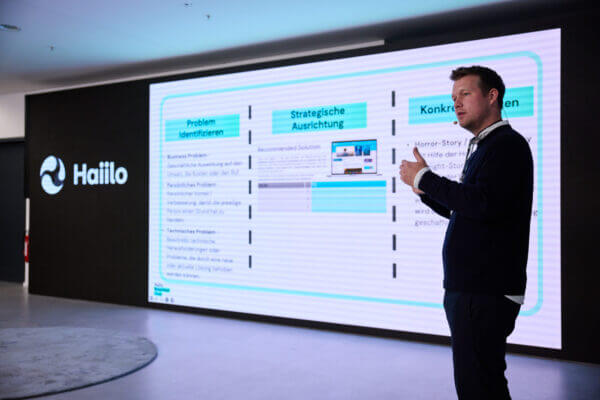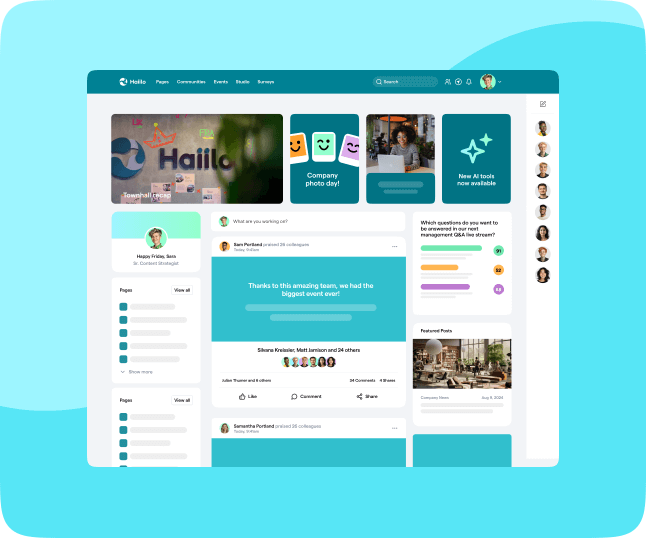In 2025, the workplace is at a crossroads – or perhaps, as Gallup puts it more starkly, at a breaking point.
For leaders, HR professionals, and IT stakeholders shaping the future of work, the stakes could not be higher. Gallup’s State of the Global Workplace report is an in-depth look at a global workforce teetering on the edge of seismic transformation.
It chronicles a year marked by declining engagement, deteriorating wellbeing, and growing disconnection. In particular, among the people expected to hold it all together: managers.
But this is not just a story of warning. It’s one of hope. The data also reveals a once-in-a-generation opportunity – a potential US$9.6 trillion productivity boom waiting to be unlocked.
Let’s look at the key findings, explore what they mean, and how the right digital platforms can help organizations thrive in the new world of work.
Engagement is falling – and managers are at the heart of it
Globally, only 21% of employees are engaged at work, down two points from the previous year. That decline matches a drop seen during the peak of the COVID-19 pandemic, and it’s not just a blip. It’s a symptom of a deeper malaise.
What’s driving this disengagement? According to Gallup, the answer is clear: managers.
Manager engagement dropped from 30% to 27%. Young managers under 35 saw a five-point dip. For female managers, the fall was even steeper: seven points. Meanwhile, individual contributor engagement held steady at 18%. The spotlight is squarely on the people caught between executive mandates and frontline reality: managers who are burned out, unsupported, and increasingly adrift.
This matters because 70% of team engagement is driven by the manager. Disengaged managers = disengaged teams = lower productivity, higher turnover, and real damage to business outcomes.
According to Ryan S, a Supervisor in the US, “my guys will do anything I ask of them, but there’s no enthusiasm. You can just feel it.”
This isn’t just anecdotal. It’s systemic. It’s global. And it’s deeply human.
💡Read: Why culture and engagement matter in the modern workplace
Wellbeing is worsening – especially for those in charge
Alongside engagement, employee wellbeing is declining. Gallup’s Life Evaluation metric, which measures how people feel about their lives overall, dropped to just 33% thriving globally. But again, the heaviest impact is among managers.
Older managers saw a 5% drop in wellbeing. For female managers, it was 7%. While individual contributors saw slight improvements, the people leading them are increasingly struggling to cope.
According to Anneliese A, an Operations Manager in Germany, “I notice that I’m physically tired, but I can’t sleep and can’t switch off.”
It’s a perfect storm. Managers are expected to juggle shrinking budgets, high turnover, reorganized teams, rising employee expectations, and the relentless pace of digital transformation – all without adequate support or training.
And if managers aren’t thriving, their teams won’t either. Burnout at the top trickles down fast.

But here’s the hope: a trillion-dollar opportunity
For all the doom and gloom, Gallup’s report is not without optimism. In fact, it’s full of potential. If global engagement levels rose from today’s 21% to a more aspirational 70%, the result would be a staggering US$9.6 trillion in additional productivity. That’s equal to 9% of global GDP.
Is 100% engagement realistic? Maybe not. But Gallup shows that some best-practice organizations already operate at 70% engagement and above. What do they have in common?
- Science-based management practices
- Strong cultural alignment
- Relentless focus on manager enablement
This is no fantasy – it’s happening today, across industries and regions. The key is leadership, strategy, and sustained investment in people.
The three fixes: what leaders must do
Gallup outlines three concrete actions for reversing the engagement crisis and building a thriving workplace:
1. Train every manager
Less than 44% of managers globally have received training. Yet Gallup finds that training cuts active disengagement in half.
Even basic support like understanding role responsibilities, managing conflict, setting expectations can help managers feel less overwhelmed and more in control.
2. Teach coaching skills
Leadership isn’t about command-and-control. It’s about coaching. Managers trained in coaching practices see 20–28% improvements in performance, and their teams experience up to 18% higher engagement.
This isn’t soft stuff. It’s strategic and science-based.
3. Develop manager wellbeing
Providing training alone boosts thriving from 28% to 34%. Add ongoing encouragement and development, and that number jumps to 50%.
This last point is critical. The best investment you can make in your business isn’t AI or automation. It’s manager development.

Where Haiilo comes in: empowering managers, energizing teams
Here’s the final – and perhaps most important – takeaway: Technology can make this easier.
💡Read: How digital fatigue is hurting your team
In an era defined by burnout and disconnection, digital platforms like Haiilo are uniquely positioned to support the transformation Gallup calls for.
Here’s how:
✅ Communication that connects
Haiilo helps close the gap between leaders, managers, and employees with internal communications that are personal, purposeful, and aligned to your company’s mission. When everyone knows the “why,” they’re more likely to care about the “how.”
✅ Enablement at scale
From mobile intranet to tailored content for every role, Haiilo helps managers coach, guide, and lead more effectively – without getting buried in admin. Training materials, surveys, feedback tools, and recognition features are right at your fingertips.
✅ Engagement analytics
You can’t improve what you can’t measure. Haiilo’s analytics give HR and leadership teams real-time insights into what’s working, what’s not, and where to act next. It’s a manager’s dashboard for engagement and sentiment.
✅ Culture you can feel
Haiilo’s platform fosters connection and belonging – the human elements Gallup warns are under threat in the AI era. From shout-outs to shared stories to community spaces, it helps rekindle the bonds that turn a workforce into a team.
The moment is now
Gallup’s report is more than a mirror. It’s a map. It shows the urgency of rethinking how we support and empower our managers (and the massive payoff waiting on the other side).
But transformation doesn’t happen on sentiment alone. It takes action. It takes systems. It takes platforms designed not just to digitize work, but to humanize it.
That’s where Haiilo comes in.
Because when you equip your managers to lead with clarity, purpose, and care, everyone wins.
Want to see how Haiilo engages your people? (managers included)





